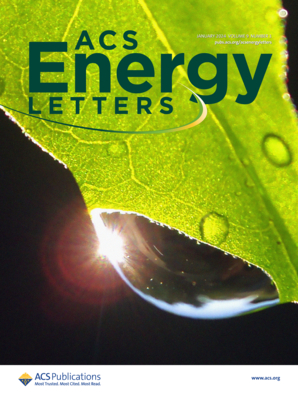Operando Optical Microscopy for Visualization of Dendrite Growth in an Argyrodite LPSCl–Polymer Composite Electrolyte
IF 19.3
1区 材料科学
Q1 CHEMISTRY, PHYSICAL
引用次数: 0
Abstract
Herein, we demonstrate the utility of optical microscopy as an accessible technique for the in situ visualization of dendrite growth within polymer–sulfide composite solid-state electrolytes. The composite electrolyte features in situ polymerization and cross-linking of the polymer between ceramic particles, which opens up extensive opportunities for accelerated materials discovery, given the vast array of acrylate/methacrylate monomers available. Specifically, the cross-linked polymer poly(triethylene glycol dimethacrylate) (poly(TEGDMA)) was observed to effectively fill pores and inhibit dendrite growth at the lithium metal interface, attributed to its glassy state at room temperature. This work represents the first application of optical microscopy to illustrate that the incorporation of glassy, undoped polymers such as poly(TEGDMA) can serve as a viable strategy for dendrite suppression in solid-state composite electrolytes.

用光学显微镜观察银柱石lpscl -聚合物复合电解质中枝晶生长
在这里,我们展示了光学显微镜的实用性,作为一种可访问的技术,用于原位可视化聚合物-硫化物复合固态电解质中的枝晶生长。复合电解质的特点是原位聚合和陶瓷颗粒之间的聚合物交联,这为加速材料的发现开辟了广泛的机会,因为有大量的丙烯酸酯/甲基丙烯酸酯单体可用。具体来说,交联聚合物聚(三甘醇二甲基丙烯酸酯)(聚(TEGDMA))被观察到可以有效地填充孔隙并抑制锂金属界面处的枝晶生长,这归因于其在室温下的玻璃态。这项工作代表了光学显微镜的首次应用,说明了玻璃状未掺杂聚合物(如聚(TEGDMA))的掺入可以作为固态复合电解质中枝晶抑制的可行策略。
本文章由计算机程序翻译,如有差异,请以英文原文为准。
求助全文
约1分钟内获得全文
求助全文
来源期刊

ACS Energy Letters
Energy-Renewable Energy, Sustainability and the Environment
CiteScore
31.20
自引率
5.00%
发文量
469
审稿时长
1 months
期刊介绍:
ACS Energy Letters is a monthly journal that publishes papers reporting new scientific advances in energy research. The journal focuses on topics that are of interest to scientists working in the fundamental and applied sciences. Rapid publication is a central criterion for acceptance, and the journal is known for its quick publication times, with an average of 4-6 weeks from submission to web publication in As Soon As Publishable format.
ACS Energy Letters is ranked as the number one journal in the Web of Science Electrochemistry category. It also ranks within the top 10 journals for Physical Chemistry, Energy & Fuels, and Nanoscience & Nanotechnology.
The journal offers several types of articles, including Letters, Energy Express, Perspectives, Reviews, Editorials, Viewpoints and Energy Focus. Additionally, authors have the option to submit videos that summarize or support the information presented in a Perspective or Review article, which can be highlighted on the journal's website. ACS Energy Letters is abstracted and indexed in Chemical Abstracts Service/SciFinder, EBSCO-summon, PubMed, Web of Science, Scopus and Portico.
 求助内容:
求助内容: 应助结果提醒方式:
应助结果提醒方式:


